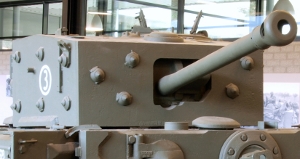Ordnance QF 75 mm
| Ordnance QF 75 mm | |
|---|---|

Gun on Cromwell tank at Overloon War Museum, Netherlands
|
|
| Type | tank gun |
| Place of origin | United Kingdom |
| Service history | |
| Used by | British Empire |
| Wars | Second World War |
The Ordnance QF 75 mm, abbreviated to OQF 75 mm, was a British tank-gun of the Second World War. It was obtained by boring out the Ordnance QF 6 pounder ("6 pdr") 57-mm anti-tank gun to 75-mm, to give better performance against infantry targets in a similar fashion to the 75mm M3 gun fitted to the American Sherman tank. The QF came from "quick-firing", referring to the use of ammunition with the shell and propellant in a single cartridge. The gun was also sometimes known as ROQF from Royal Ordnance (the manufacturer) Quick-Firing.
Prior to the introduction of the ROQF 75 mm, British tanks had been equipped with guns such as the QF 2 pounder (40-mm), and then the larger 57mm 6 pounder. These guns were designed to fire armour-piercing shot, small high-velocity solid rounds that were effective against tanks, but did little damage to groups of infantry or soft targets like trucks. Some tanks operating in the infantry support role were given howitzers firing HE shells, such as early models of the Churchill and CS (Close Support) versions of the Matilda II. The decision to equip British tanks with a gun capable of firing HE shells at soft targets was taken by the War Office.
A HE shell for the 6 pounder was in production by the start of the Tunisia Campaign and available in large numbers in the Italian Campaign. However, the round lacked sufficient explosive power. The power of the US 75mm HE round used in the 75mm M3 was found to be markedly superior, and a number of Churchills in operation in Italy had guns scavenged from Sherman tanks and fitted to their turrets to give the Churchill NA75 (NA coming from "North Africa" where the conversions were carried out). Approximately 200 were converted in this way.
...
Wikipedia
